|

Presented by
Wm. Max Miller,
M. A.
Click on Anubis to learn about our logo and banners.
About Our Project
Project Updates
See what's new at the T. R. M. P.
Quickly Access Specific Mummies With Our
Mummy Locator
Or
View mummies in the
following Galleries:
XVII'th
Dynasty
Gallery I
XVIII'th
Dynasty
Gallery I
Gallery II
Including the mummy identified as Queen Hatshepsut.
Gallery III
Including the mummy identified as Queen Tiye.
Gallery
IV
Featuring the controversial KV 55
mummy. Now with a revised reconstruction of ancient events in this perplexing
tomb.
Gallery V
Featuring the mummies of Tutankhamen and his children.
Still in preparation.
XIX'th
Dynasty
Gallery I
Now including the
mummy identified as
Ramesses I.
XX'th
Dynasty
Gallery I
XXI'st
Dynasty
Gallery I
Gallery II
21'st Dynasty Coffins from DB320
Examine the coffins
of 21'st Dynasty Theban Rulers.
Unidentified Mummies
Gallery I
Including the mummy identified as Tutankhamen's mother.
About the Dockets
Inhapi's Tomb
Using this website for research papers
Acknowledgements
Links to Egyptology websites
Biographical Data about William Max Miller
Special Exhibits
The Treasures of Yuya and Tuyu
View
the funerary equipment of Queen Tiye's parents.
Tomb
Raiders of KV 46
How thorough were the robbers who plundered the tomb of
Yuya and Tuyu? How many times was the tomb robbed, and what were the thieves
after? This study of post interment activity in KV 46 provides some answers.
Special KV 55 Section
========
Follow the trail of the missing treasures from mysterious KV 55.
KV
55's Lost Objects: Where Are They Today?
The KV 55 Coffin Basin
and Gold Foil Sheets
KV 55
Gold Foil at the Metropolitan
Mystery of the Missing Mummy Bands
KV
35 Revisited
See rare photographic plates of a great
discovery from Daressy's Fouilles de la Vallee des Rois.
Unknown Man E
Was he really
buried alive?
The
Tomb of Maihirpre
Learn about Victor Loret's
important discovery of this nearly intact tomb in the Valley of the Kings.
Special Section:
Tomb Robbers!
Who were the real tomb raiders?
What beliefs motivated their actions? A new perspective on the ancient practice
of tomb robbing.
Special Section:
Spend a Night
with the Royal Mummies
Read Pierre Loti's eerie account of
his nocturnal visit to the Egyptian Museum's Hall of Mummies.
Special Section:
An
Audience With Amenophis II Journey
once more with Pierre Loti as he explores the shadowy chambers of KV 35 in the
early 1900's.

Most of the images on this website have been
scanned from books, all of which are given explicit credit and, wherever
possible, a link to a dealer where they may be purchased. Some images derive
from other websites. These websites are also acknowledged in writing and by
being given a link, either to the page or file where the images appear, or to
the main page of the source website. Images forwarded to me by individuals who
do not supply the original image source are credited to the sender. All written
material deriving from other sources is explicitly credited to its author.
Feel free to use material from the Theban Royal Mummy Project website.
No prior written permission is required. Just please follow the same guidelines
which I employ when using the works of other researchers, and give the Theban
Royal Mummy Project proper credit on your own papers, articles, or
web pages.
--Thank You
This website is constantly developing and contributions
of data from other researchers are welcomed.
Contact The Theban Royal Mummy Project at:
anubis4_2000@yahoo.com
Background Image: Wall scene from the tomb of Ramesses II (KV 7.) From Karl
Richard Lepsius, Denkmäler (Berlin: 1849-1859.)

| |

Special Exhibit
The Tomb of Maihirpre
Gallery I
Opened February 17, 2001
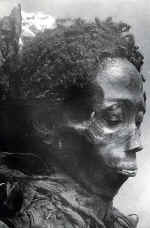
In
March, 1899 (exactly one year after his discovery of the cache tomb of Amenhotep
II) Victor Loret ordered his workmen to make a series of sondages in an
area of the Valley of the Kings between the tombs of Tuthmosis
I (KV
38) and Amenhotep
II (KV
35.) He eventually uncovered a shaft, approximately twenty six feet
deep, with a small chamber cut into one side. Loret descended the shaft, entered
the chamber, and made another remarkable find: the first essentially intact tomb
ever found in the
Valley of the Kings. Inscriptional evidence indicated that the small tomb (KV
36) belonged to a man named Maihirpre.
His funerary equipment constituted the most complete assemblage of such objects
found in the Valley up to that time, and would remain so until Theodore Davis
discovered the tomb of Yuya and Tuyu (KV 46) in 1905.
Obviously of 18'th Dynasty derivation, the exact
date of the burial is still disputed, and evidence from the tomb can lend support to several different dating schemes. A linen
wrapping found on Maihirpre's mummy bears the cartouche of Hatshepsut.
Influenced by the presence of this cartouche, Steindorff speculated that
Maihirpre might have been a companion of Tuthmosis I, Hatshepsut's father.
Quibell also based his conclusions on the Hatshepsut cartouche (as well as
on pottery considerations) but argued that the tomb should be dated to the time
of Tuthmosis III, and
Daressy accepted Quibell's dating in his Fouilles.
Today, some researchers believe that the linen wrapping with the Hatshepsut
cartouche was a kind of antique, old
in Maihirpre's lifetime, because other objects in KV 36 clearly point to periods
later than that of the female Pharaoh. One of these, a beautiful glass vase, has
been dated to the reign of Amenhotep II on stylistic grounds. In his 1908 Guide
to the Cairo Museum, Gaston Maspero also dates Maihirpre's burial
to the reign of Amenhotep II, a view which was shared by Hayes, G. E. Smith, and
Cyril Aldred. However, Maspero changed his mind in the 1915
edition of his Guide, in which he dated KV 36 to the time of
Amenhotep III,
a date which was also accepted by Rex Engelbach.
Maspero probably based his view on a consideration of the box and
loincloths of Maihirpre found along with a fragmentary box of Amenhotep
III in
1902 by Howard Carter. Maihirpre's
coffins, sarcophagus and canopic equipment (see below) bear a close
stylistic resemblance to the funerary ensemble of Yuya and Tuyu,
and would also seem to derive from sometime during the reign of
Amenhotep III. C. N. Reeves dates KV 36 to the time
of Tuthmosis IV, a view also held by Alfred Lucas and his reviser, J.
R.
Harris.
Never properly published by Loret,
the only account of the discovery written while the objects were still in
situ within KV 36 was penned by Georg
Schweinfurth, a botanist, and appeared in the popular German magazine Vossische Zeitung on
May 25, 1899. Three years later, Georges Daressy published photographic plates
of the mummy and the tomb's contents in his Catalogue General des Antiquites Egyptiennes du Musee du
Caire:
Fouilles de la Vallee des Rois ([Cairo, 1902,] pp. 281-298) and this long out of print book has remained
the only extensive photographic record of the find ever published. Unless otherwise
indicated, the photographs of Maihirpre and his funerary equipment used on this
website are from Daressy's work. They provide a
valuable visual record of an important Egyptological discovery that has
been largely forgotten by the general public today.
(See color photo of Maihirpre’s mummy [from Forum égyptologique L'Egypte pharaonique et celle d'aujourd'hui.] To learn more about Maihirpre and his tomb, see Natalia Klimczak’s article [available on the Ancient Origins website for June 15, 2016.])
Go
to KV 36 Bibliography
 The
Mummy of Maihirpre The
Mummy of Maihirpre
Maihirpre's mummy (at right and above) was found
resting in a nested set of two coffins contained within a large rectangular
wooden sarcophagus. Schweinfurth reported that thieves had removed some of the
bandages from the mummy, and his statement was confirmed by Daressy, who added
the detail that large sections of bandages had been cut with a sharp instrument
which had been applied with particular force to the bandages of the legs. Reeves
dates this illicit activity in Maihirpre's tomb to the Ramesside period based on
the evidence of 20'th Dynasty ostraca found in the vicinity of KV 36 by Howard
Carter in 1902.
In spite of its ill-treatment by tomb robbers, Maihirpre's
mummy retained its cartonnage mummy mask and still had about a dozen different
articles of jewelry in place among the tattered bandages or lying loose in the
coffin. Among these were bracelets, collars, plaques, and a scarab. The
embalming incision was still covered with a plain gold plate which the thieves
had also managed to miss.
The mummy itself, which was unwrapped on March 22, 1901, was
very well preserved. According to Daressy, Maihirpre was a young man when
he died, probably not much over 20 years of age. Dennis Forbes reminds us that
Daressy was not a trained anatomist and that his estimate of Maihirpre's age at
death is "certainly not expert opinion." However, it seems evident
that Maihirpre was far from being elderly. The fact that his teeth are only
mildly worn is a good indication of a young age at death. The ancient Egyptian
practice of mixing grain with sand and grit in order to aid the grinding process produced
a kind of bread that was dentally abrasive and able to wear down the teeth in
relatively short order.
Maihirpre's mummy measures 5 feet, 4.75 inches and his skin
is dark brown. Daressy believed that this skin color is not the result of
chemical reactions with the embalming materials, and most writers contend the
Maihirpre was at least part Nubian. The curly hair which is so visibly prominent
on the mummy's head would initially seem to confirm Maihirpre's Nubian ancestry,
but is in fact a very realistic wig glued securely in place over his shaven
scalp. Maihirpre's ears were pierced, and he was uncircumcised. No wounds or
obvious signs of illness appear on his body that might help to indicate the
cause of his death, but, as Dennis Forbes points out, Maihirpre has never been
examined by an experienced anatomist. The skin was missing on the soles of his
feet, but this probably occurred during the embalming process.
Maihirpre bore several important titles. He was referred to
as a "child of the k3p," a title normally used to
designate a foreign prince who had been raised from an early age in Egypt.
This practice, which came into vogue during the New Kingdom, helped to cultivate
a sense of loyalty toward Egypt in the children of vassal-state rulers. He also bore the important title "fanbearer to the
king" and was one of the earliest people to hold this designation. Dennis
Forbes points out that this title was often held by the Viceroy of Kush himself. Maspero
speculated that Maihirpre may have been the son of Tuthmosis IV or Amenhotep III
and a Nubian concubine, but no hard inscriptional evidence supports this. It is
hard to imagine a son of the Pharaoh, even by a lesser concubine, who would not
unambiguously proclaim his half-royal parentage in one of his personal
titles.
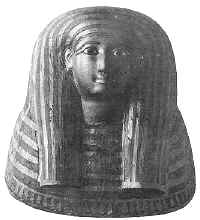 Mummy Mask Mummy Mask
CG 24096
Maihirpre's mummy mask, made of cartonnage, displays features which date it to
the reign of either Amenhotep II or Tuthmosis IV. It lacks the feather/wing
decorations which characterize mummy masks of the early 18'th Dynasty, but has
not evolved the graceful lines and proportions seen in later masks from the time
of Amenhotep III. It is striped in black resin and gold foil which repeats the
decorative scheme of Maihirpre's outer coffin. The eyes are of inlaid black and
white stone.
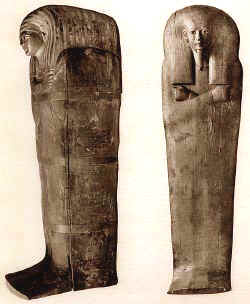 Middle
and Inner Coffins Middle
and Inner Coffins
CG 24003-4
Maihirpre's middle coffin (at left in photo) had
its gold foil decoration in place but was never given its coating of black
resin. The absence of the resin indicates that the Egyptians may have applied it
to such coffins only when they were in place in the tomb. This coffin was left
unfinished because it was found to be too small to contain the inner coffin of
the set. It was found, unused and overturned, on the floor in the middle of the
tomb. The inner coffin (at right in photo) is completely gilded. Unlike
the more ornate gilded inner coffins of Yuya and Tuyu, this coffin has hands crossed over the chest
but does not have stone inlays. The decorations
are cut into the gilded plaster.
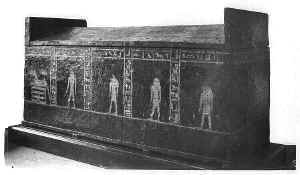 Wooden
Sarcophagus Wooden
Sarcophagus
CG 24001
Maihirpre's large wooden sarcophagus, measuring over 9 feet
in length, is coated with black resin and decorated in gold foil. Anubis and the
Four Sons of Horus line the sides. Isis appears at the foot end. The decorative
scheme mirrors that used on high status coffins of the period.
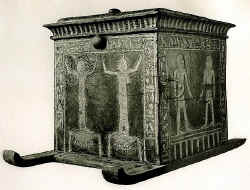 Wooden
Canopic Chest Wooden
Canopic Chest
CG 24005
Isis, Nepthys, and the Four Sons of Horus,
depicted in gold foil, guard the canopic chest of Maihirpre. The use of gold on
the chest is another indication of Maihirpre's high status. Most non-royal
canopic chests of this period were decorated with yellow paint. The per wer
shaped lid with cornice is similar to that used on Tutankhamen's calcite canopic
chest.
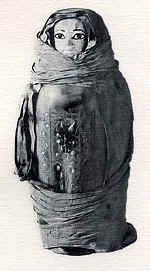
Canopic
Jar
CG 24006
Maihirpre's four calcite canopic jars do not
match. Two have very traditional stoppers with large-faced, human heads, but
the other two have human headed stoppers with smaller, more delicate features. The
jars with the smaller-faced stoppers--one of which is seen at left--possess an
unusual, doll-like quality. Human headed canopic jars were common until the
20'th Dynasty, when animal heads, used to represent three of the Four Sons
of Horus, became the vogue. All four of Maihirpre's canopic jars were inscribed with protective spells and
wrapped with linen.
See
more objects from Maihirpre's tomb:
Book
of the Dead & Osiris Bed
Jars,
Vases & Bowls
Quivers,
Arrows & Dog Collars
|










